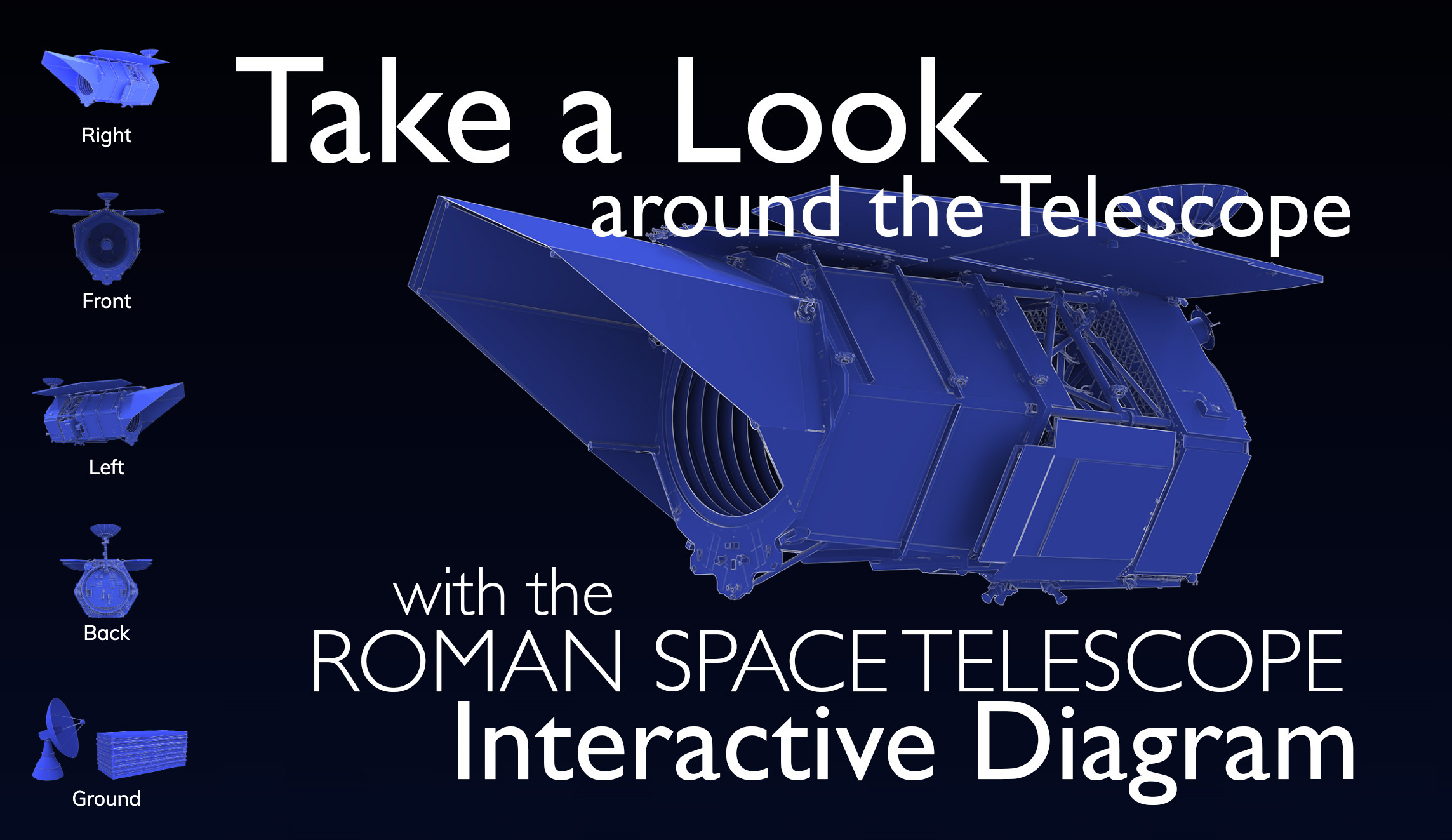Mission and Observatory
The Nancy Grace Roman Space Telescope is a next-generation observatory due for launch no later than May 2027. The mission lifetime is approximately five years, with an estimated close out time of three months. Key characteristics of the mission are listed below:
Access machine-readable version.
Mission and Spacecraft Parameters
- Launch date: no later than May 2027
- Duration: Five years, with a 10 year goal
- Orbit: Sun-Earth L2
- Launch Site: Kennedy Space Center, Florida, USA
- Launch Vehicle: Falcon Heavy
- Operating Temperature: 298 K
- S/C Bus:
- Downlink rate: 250-500 Mbps
- Data Volume: 11 Tbits/day
- The observatory will be supported by the following ground stations: NEN-White Sands, NM; ESA-New Norcia, Australia; JAXA – GREAT, Japan; DSN.
- Able to be refueled in-flight robotically
Telescope Parameters
- Primary Mirror size: 2.4 meters
- Primary Mirror effective diameter: 2.36 meters (diameter of the aperture stop)
- Central Obscuration: 30.3% (linear obscuration of the telescope entrance pupil; diameter ratio)
- Mirror temperature: 265 K
- Focal ratio: f/7.9 converging beam produced by the telescope for the WFI (for the Coronagraph, the telescope produces a collimated beam)
- Allowed roll angle range: -15 to +15 degrees around angle providing max solar power
- Allowed pitch angle range: 54-126 degrees (0 degrees = towards the Sun; 180 degrees = away from the Sun)
- Allowed yaw angle range: 0-360 degrees (about the Sun line)
- Jitter: 8 milliarcseconds
- Drift: 8 milliarcseconds
Observatory Instrumentation
An Expanded view of the observatory
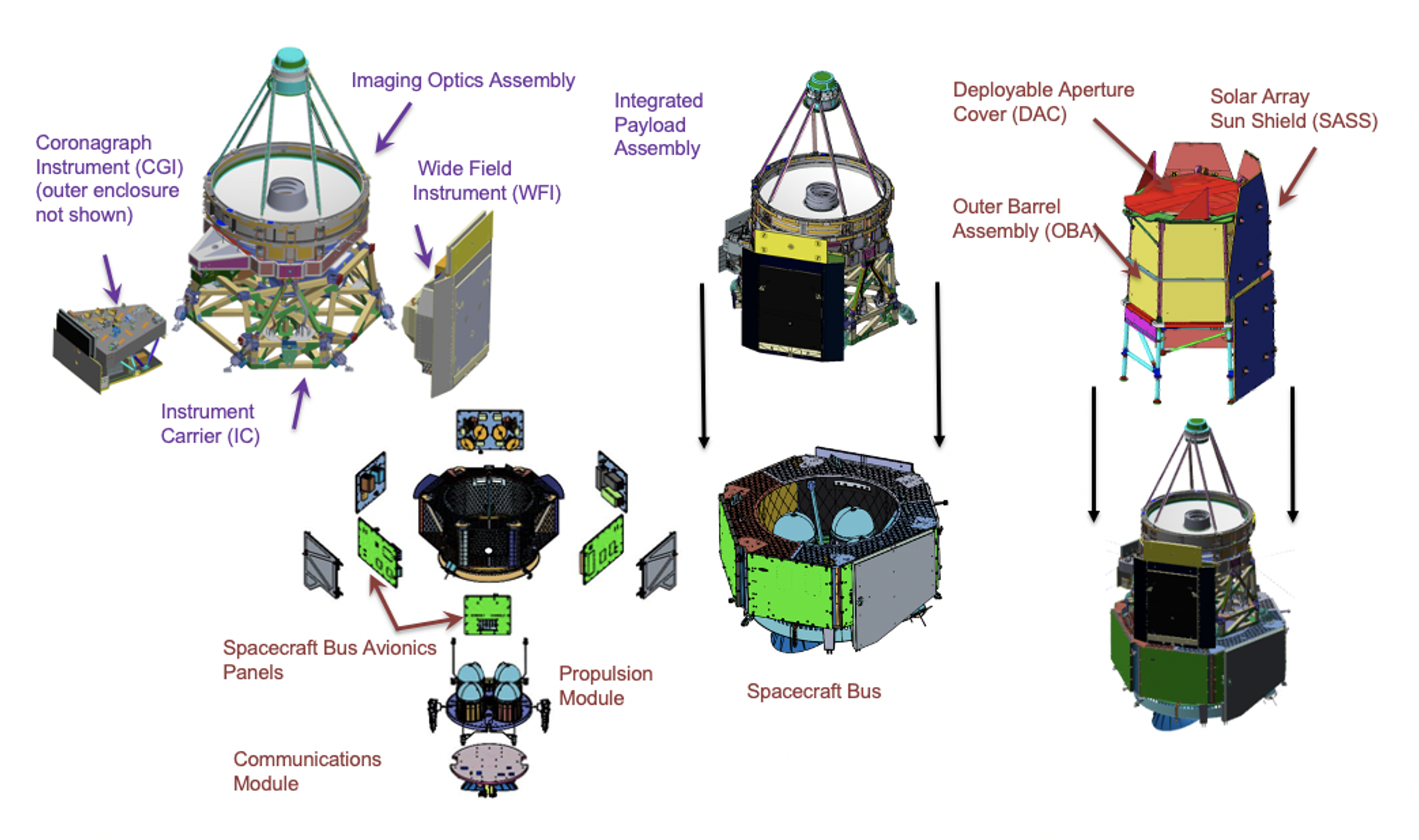
The Roman observatory split into its spacecraft (red) and integrated payload (purple) components.
Observations
(Field of Regard, Slew/Settle Times, etc.)
Field of Regard and Optical Field Layout
The Roman field of regard and optical field layout are illustrated below. These figures provide information about the observing zones, and the angles between the detectors and the instruments.
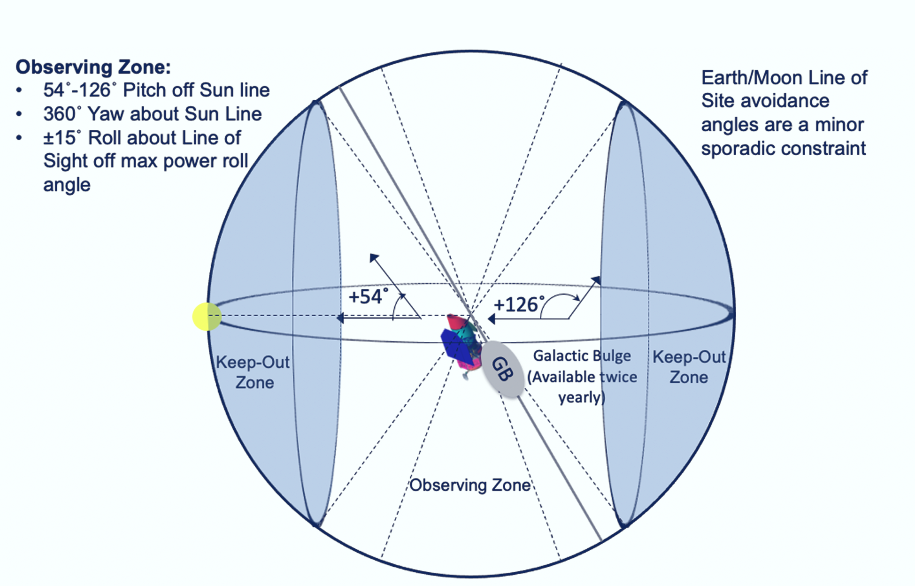
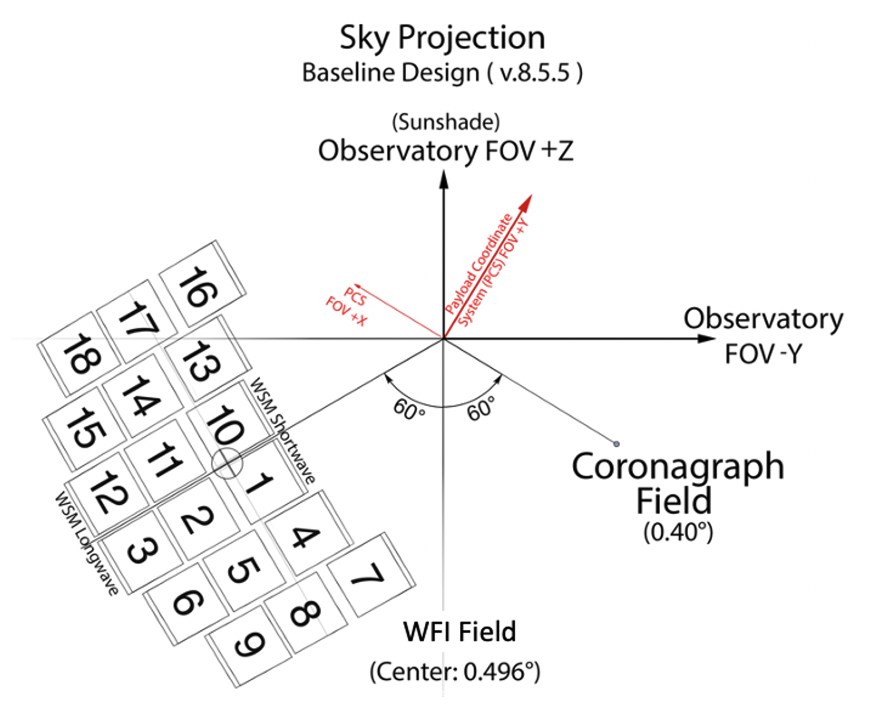
Slew times
(Dec 2023)
Slew duration and the slew profile are determined by the slew length, the maximum allowed rate, and the maximum allowed acceleration. The maximum allowed rate is fixed (by observatory safing constraints). The maximum allowed acceleration is determined by the torque authority of the reaction wheels and the moment of inertia of the observatory. The torque is slightly different in the direction of the long axis of the WFI FoV than the short axis. For the purpose of estimating survey efficiency, slew times in the diagonal direction is a reasonable approximation.
Slews are acceleration limited if the rate does not reach the maximum value, and rate-limited for longer slews (>~1deg) where the maximum rate is achieved. Since the maximum allowed rate is fixed, improvements in torque authority primarily improve the performance of short slews. Roman's core community surveys are dominated by short slews.
Sharp changes in acceleration may excite structural or slosh oscillations that could adversely affect settling time. To avoid this, a shaped profile is computed onboard to avoid sharp acceleration discontinuities. More details can be found in Stoneking et al 2017.
The times for some example telescope slews are presented in the table below. These include settling time. These assume 1.566 Nm max torque, and MOI of 40,000 kg*m2
| Slew type | Slew angle (deg) | Slew time (s) |
|---|
| Gap Fill | 0.025 | 18.9 |
| Short FoV | 0.4 | 39.3 |
| Long FoV | 0.8 | 52.5 |
| 2-deg | 2.0 | 77.8 |
| 5-deg | 5.0 | 141 |
| 10-deg | 10.0 | 246 |
| 30-deg | 30.0 | 646 |
| 90-deg | 90.0 | 1844 |
Access machine-readable version.
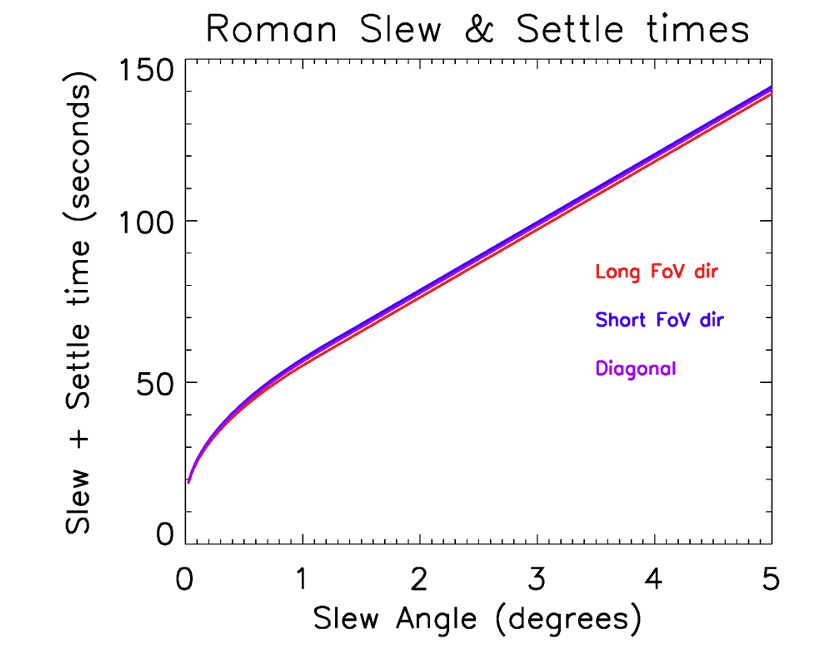
Download a text table with fine sampling of slew+settle times vs deg here.
Target Visibility and Available Roll Angles
Example visibility plots for two different target declinations are provided below. The Y-axis is the R.A, and the X-axis is the day of the year. The regions in green represent where/when the line of sight is in the Roman field-of-regard. A full set of visibility plots with declination increasing at intervals of 5 degrees is available here.
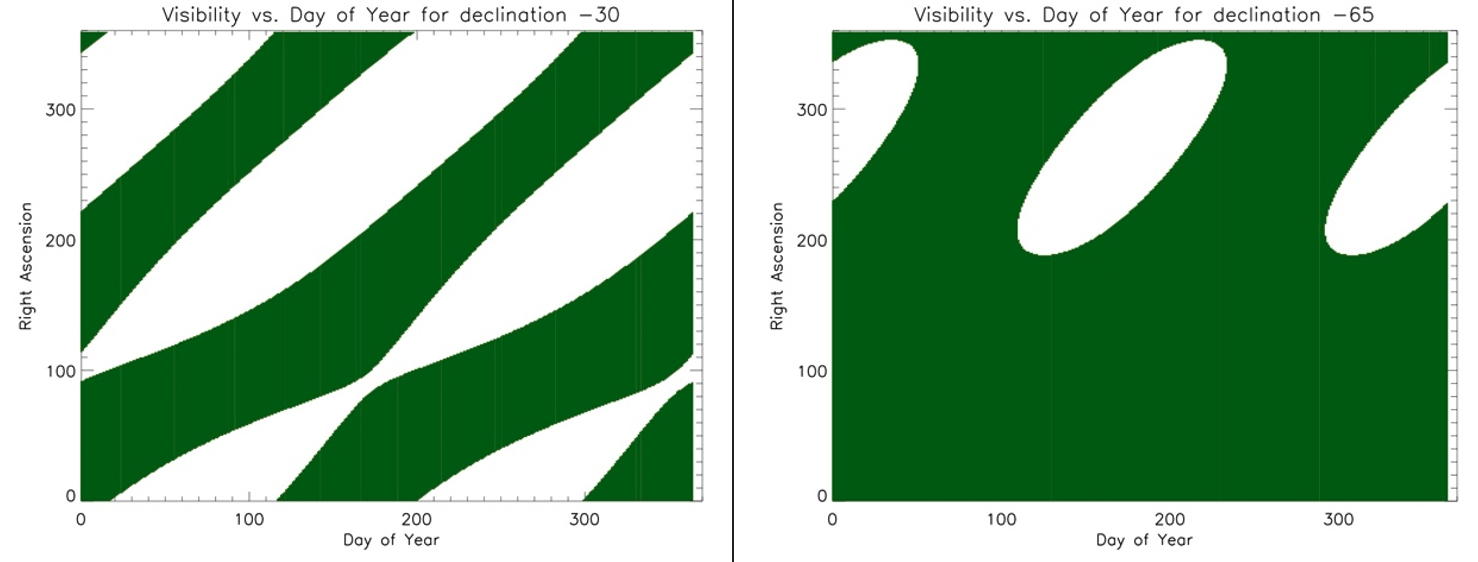
Image Caption: Visibility plots at Dec. = -30 deg (left) and -65 deg (right), with regions in green representing where/when the line of sight is in the field-of-regard.
The plot on the left corresponds roughly to the Galactic center if one were to draw a horizontal line at R.A = 266 deg. The spring and fall visibility windows are where that line intersects the green regions.
In the plot on the right, the ecliptic pole is at RA = 90 deg. This means that the bottom half of the plot is in the continuous viewing zone, which is why it is solid green.
The nominal roll angle for an arbitrary R.A and Dec., as a function of time throughout the year has been computed and can be found here.
This file contains two sets of columns for +/- values of Dec. = 1, 60, and 89 deg. The target R.A was fixed at +90 deg. By focusing on the month and day columns of the file, and the two pitch OK columns, a user may determine which days have the given R.A and Dec. in the field-of-regard. The roll columns give the S/C roll.
For example, if a user were to look at the low declination examples in the file (Dec. = 1 and -1 deg), they would observe that the roll angle doesn’t change much during the good days, because these lines of sight are still not too far from the ecliptic plane. However, if one were to look at the Dec. =-60 deg columns, the roll angle covers all of 0-360 deg. This is due to the fact that with target R.A = 90 deg, the target is in the continuous viewing zone.
If you'd like to explore visibility and available roll angles for yourself, we have provided a Python script here.
Orbit
Here are orbits for 4 different cases
The step size is one day, and it is in Earth J2000 coordinates.
The orbit does not have a significant effect on target visibility, but might be useful for other studies (e.g. parallax)




